
Agnatha is a superclass of jawless fish in the phylum Chordata, subphylum Vertebrata, consisting of both present (cyclostomes) and extinct species. The group is sister to all vertebrates with jaws, known as gnathostomes.

Gnathostomata are the jawed vertebrates. The term derives from Greek: γνάθος "jaw" + στόμα "mouth". Gnathostome diversity comprises roughly 60,000 species, which accounts for 99% of all living vertebrates. In addition to opposing jaws, living gnathostomes have teeth, paired appendages, and a horizontal semicircular canal of the inner ear, along with physiological and cellular anatomical characters such as the myelin sheaths of neurons. Another is an adaptive immune system that uses V(D)J recombination to create antigen recognition sites, rather than using genetic recombination in the variable lymphocyte receptor gene.
Jiang / Chiang can be a Mandarin transliteration of one of several Chinese surnames:

The Gan River travels 885 km (550 mi) north through the western part of Jiangxi before flowing into Lake Poyang and thus the Yangtze River. The Xiang-Gan uplands separate it from the Xiang River of neighboring eastern Hunan.

Galeaspida is an extinct taxon of jawless marine and freshwater fish. The name is derived from galea, the Latin word for helmet, and refers to their massive bone shield on the head. Galeaspida lived in shallow, fresh water and marine environments during the Silurian and Devonian times in what is now Southern China, Tibet and Vietnam. Superficially, their morphology appears more similar to that of Heterostraci than Osteostraci, there being currently no evidence that the galeaspids had paired fins. However, Galeaspida are in fact regarded as being more closely related to Osteostraci, based on the closer similarity of the morphology of the braincase.

Pachypleurosaurs were primitive sauropterygian reptiles that vaguely resembled aquatic lizards, and were limited to the Triassic period. They were elongate animals, ranging in size from 20 cm to about a metre in length, with small heads, long necks, paddle-like limbs, and long deep tails. The limb girdles are greatly reduced, so it is unlikely these animals could move about on land. The widely spaced peg-like teeth project at the front of the jaws, indicate that these animals fed on fish.
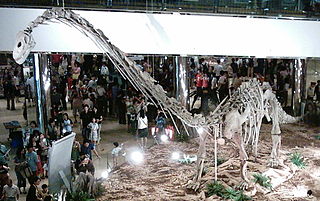
Omeisaurus is a genus of sauropod dinosaur from the Middle Jurassic Period of what is now China. Its name comes from Mount Emei, where it was discovered in the lower Shaximiao Formation of Sichuan Province.

Szechuanosaurus is an extinct genus of carnivorous theropod dinosaur from the Late Jurassic. Fossils referred to the genus have been found in China, Asia in the Oxfordian-?Tithonian. Its type species is largely based on several undiagnostic teeth from the Shangshaximiao Formation and it is possibly also known from the Kuangyuan Series and the Kalaza Formation, both also located in China.

Tylototriton is a genus of newts known as crocodile newts or knobby newts. About 25 known species are in this genus. Many species have been described just recently. They range from northeastern India and Nepal through Burma to northern Thailand, Laos, Vietnam, and southern China.
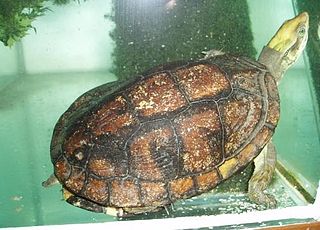
Pan's box turtle is a species of turtle in the family Geoemydidae. The yellow-headed box turtle is sometimes included herein as a subspecies.
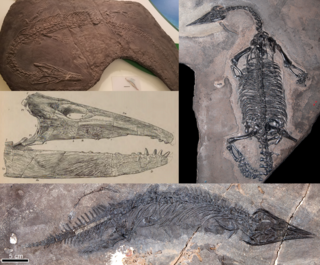
Thalattosauria is an extinct order of prehistoric marine reptiles that lived in the middle to late Triassic period. Thalattosaurs were diverse in size and shape, and are divided into two superfamilies: Askeptosauroidea and Thalattosauroidea. Askeptosauroids were endemic to the Tethys Ocean, their fossils have been found in Europe and China, and they were likely semiaquatic fish eaters with straight snouts and decent terrestrial abilities. Thalattosauroids were more specialized for aquatic life and most had unusual downturned snouts and crushing dentition. Thalattosauroids lived along the coasts of both Panthalassa and the Tethys Ocean, and were most diverse in China and western North America. The largest species of thalattosaurs grew to over 4 meters (13 feet) in length, including a long, flattened tail utilized in underwater propulsion. Although thalattosaurs bore a superficial resemblance to lizards, their exact relationships are unresolved. They are widely accepted as diapsids, but experts have variously placed them on the reptile family tree among Lepidosauromorpha, Archosauromorpha, ichthyosaurs, and/or other marine reptiles.
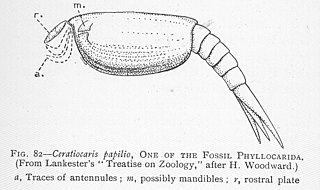
Ceratiocaris is a genus of paleozoic phyllocarid crustaceans whose fossils are found in marine strata from the Upper Ordovician until the genus' extinction during the Silurian. They are typified by eight short thoracic segments, seven longer abdominal somites and an elongated pretelson somite. Their carapace is slightly oval shaped; they have many ridges parallel to the ventral margin and possess a horn at the anterior end. They are well known from the Silurian Eramosa formation of Ontario, Canada.

Wumengosaurus is an extinct aquatic reptile from the Middle Triassic Guanling Formation of Guizhou, southwestern China. Originally described as a basal eosauropterygian, and usually recovered as such by recent phylogenetic analyses, one recent phylogeny has placed it as the sister taxon to Ichthyosauromorpha while refraining from a formal re-positioning.

The evolution of fish began about 530 million years ago during the Cambrian explosion. It was during this time that the early chordates developed the skull and the vertebral column, leading to the first craniates and vertebrates. The first fish lineages belong to the Agnatha, or jawless fish. Early examples include Haikouichthys. During the late Cambrian, eel-like jawless fish called the conodonts, and small mostly armoured fish known as ostracoderms, first appeared. Most jawless fish are now extinct; but the extant lampreys may approximate ancient pre-jawed fish. Lampreys belong to the Cyclostomata, which includes the extant hagfish, and this group may have split early on from other agnathans.
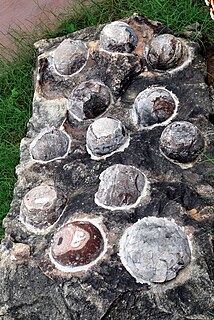
Egg fossils are the fossilized remains of eggs laid by ancient animals. As evidence of the physiological processes of an animal, egg fossils are considered a type of trace fossil. Under rare circumstances a fossil egg may preserve the remains of the once-developing embryo inside, in which case it also contains body fossils. A wide variety of different animal groups laid eggs that are now preserved in the fossil record beginning in the Paleozoic. Examples include invertebrates like ammonoids as well as vertebrates like fishes, possible amphibians, and reptiles. The latter group includes the many dinosaur eggs that have been recovered from Mesozoic strata. Since the organism responsible for laying any given egg fossil is frequently unknown, scientists classify eggs using a parallel system of taxonomy separate from but modeled after the Linnaean system. This "parataxonomy" is called veterovata.
This list of fossil fishes described in 2015 is a list of new taxa of jawless vertebrates, placoderms, acanthodians, fossil cartilaginous fishes, bony fishes and other fishes of every kind that have been described during the year 2015, as well as other significant discoveries and events related to paleontology of fishes that occurred in the year 2015. The list only includes taxa at the level of genus or species.

Chinese records of comets are the most extensive and accurate in existence from the ancient and medieval periods, and stretch back across three millennia. Records exist at least as far back as 613 BC, and records may have been kept for many centuries before this. There are continuous records all the way through to the nineteenth century, using substantially consistent methods throughout. Chinese data accuracy is unsurpassed in the ancient world and was not overtaken by Western accuracy until the fifteenth century or, in some respects, not until the twentieth century.
Jiang Zehan, also known as Kiang Tsai-han, was a Chinese mathematician and founder of China's topology.















